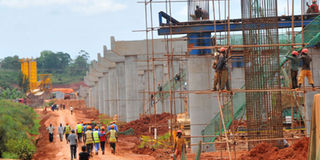Non-food inflation begins to rise

The Kampala-Entebbe Expressway under construction. High demand for money for sectors such as construction has seen Uganda’s non-food inflation rise. FILE PHOTO
What you need to know:
There is high demand for money for various sectors such as construction, services and manufacturing.
Kampala- Inflation rate in Uganda is beginning to rise on the back of non-food items.
Uganda Bureau of Statistics (Ubos) attributed this to high demand for money for various sectors such as construction, services and manufacturing, among others.
Speaking in Kampala last Friday, the director of macroeconomics, Ubos, Dr Chris Ndatira Mukiza, said the annual headline inflation rate for the year ending February 2015 increased to 1.4 per cent compared to 1.3 per cent that was registered for the year ended January 2015.
“This was mainly attributed to a 3.0 per cent rise in annual core prices for the year ending February 2015 compared to an earlier rise of 2.7 per cent that was recorded in January 2015,” he said.
Dr Mukiza explained that Uganda’s core inflation, which now stands at 3.0 per cent, is being driven by the demand for money by the general public to carryout activities in various economic sectors.
He said the increased demand in the economy is being reflected in pick up in interest in commercial loans and government securities treasury bills and bonds.
The managing director of Alpha Capital, Mr Stephen Kaboyo, told Daily Monitor last Friday that in the bond auction, rates went up to trade at 16.684 per cent for the two-year board and 17.407 per cent on the 15-year bond respectively.
“There was strong expectation that there would be renewed offshore interest in debt market and this would open up inflows and improve foreign exchange supply. The outturn suggests that impact of the flows was not significant to change the trend,” he said.
Dr Mukiza also clarified that the low headline inflation does not mean that price of goods and services are low and not rising per say but the rate at which the prices are rising is at slow pace.
Regarding the annual energy, fuel and utilities inflation, Dr Mukiza said there was a decline of 1.8 per cent in the year ending February 2015 compared to the 2.9 per cent rise which was registered in the January 2015.
Food prices expected to rise in future
The annual headline inflation rate includes food items in the Consumer Price Index has relatively been low for quite sometime supported by high food supply on the market, Ubos’ Chris Ndatira Mukiza said the annual food registered a deflation of 7.0 per cent, compared to the deflation of 6.5 per cent that was registered in January 2015.
“However, there is likelihood that there is going to be a rise in food prices, so the general public should begin to prepare for high food prices in the near future,” he said.
The monthly food inflation, which includes food crops and processed foods went up by 0.5 per cent in February 2015.
The drivers were an increase in prices of oranges, tangerine, water melon, cabbages, bitter tomatoes, green pepper, tomatoes, carrots and milk in most centres.
The annual inflation for other goods increased to 1.8 per cent in February 2015 compared to 1.4 per cent recorded for the year ended January 2015.
The annual inflation for services declined to 4.3 per cent in February 2015 compared to the 4.4 per cent recorded for the year ended January 2015.
moketch @ug.nationmedia.com




